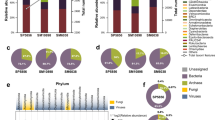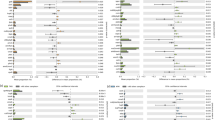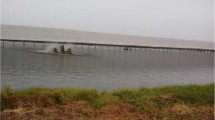Abstract
The ocean is a natural habitat for antibiotic-producing bacteria, and marine aquaculture introduces antibiotics into the ocean to treat infections and improve aquaculture production. Studies have shown that the ocean is an important reservoir of antibiotic resistance genes. However, there is a lack of understanding and knowledge about the clinical importance of the ocean resistome. We investigated the relationship between the ocean bacterial resistome and pathogenic resistome. We applied high-throughput sequencing and metagenomic analyses to explore the resistance genes in bacterial plasmids from marine sediments. Numerous putative resistance determinants were detected among the resistance genes in the sediment bacteria. We also found that several contigs shared high identity with transposons or plasmids from human pathogens, indicating that the sediment bacteria recently contributed or acquired resistance genes from pathogens. Marine sediment bacteria could play an important role in the global exchange of antibiotic resistance.



Similar content being viewed by others
References
D'Costa VM, McGrann KM, Hughes DW, Wright GD (2006) Sampling the antibiotic resistome. Sci 311(5759):374–377. doi:10.1126/science.1120800
Forsberg KJ, Reyes A, Wang B, Selleck EM, Sommer MO, Dantas G (2012) The shared antibiotic resistome of soil bacteria and human pathogens. Sci 337(6098):1107–1111. doi:10.1126/science.1220761
Brown Kav A, Sasson G, Jami E, Doron-Faigenboim A, Benhar I, Mizrahi I (2012) Insights into the bovine rumen plasmidome. Proc Natl Acad Sci USA 14(109):7
Szczepanowski R, Bekel T, Goesmann A, Krause L, Krömeke H, Kaiser O, Eichler W, Pühler A, Schlüter A (2008) Insight into the plasmid metagenome of wastewater treatment plant bacteria showing reduced susceptibility to antimicrobial drugs analysed by the 454-pyrosequencing technology. J Biotechnol 136:11
Zhang T, Zhang XX, Ye L (2011) Plasmid metagenome reveals high levels of antibiotic resistance genes and mobile genetic elements in activated sludge. PLoS One 6(10):e26041. doi:10.1371/journal.pone.0026041
Weisburg WG, Barns SM, Pelletier DA, Lane DJ (1991) 16S ribosomal DNA amplification for phylogenetic study. J Bacteriol 173(2):697–703
Blankenberg D, Gordon A, Von Kuster G, Coraor N, Taylor J, Nekrutenko A (2010) Manipulation of FASTQ data with Galaxy. Bioinforma 26(14):1783–1785. doi:10.1093/bioinformatics/btq281
Zerbino DR, Birney E (2008) Velvet: algorithms for de novo short read assembly using de Bruijn graphs. Genome Res 18(5):821–829. doi:10.1101/gr.074492.107
Ma Y, Paulsen IT, Palenik B (2012) Analysis of two marine metagenomes reveals the diversity of plasmids in oceanic environments. Environ Microbiol 14(2):453–466. doi:10.1111/j.1462-2920.2011.02633.x
Sonnhammer EL, Eddy SR, Birney E, Bateman A, Durbin R (1998) Pfam: multiple sequence alignments and HMM-profiles of protein domains. Nucleic Acids Res 26(1):320–322
Liu B, Pop M (2009) ARDB—Antibiotic Resistance Genes Database. Nucleic Acids Res 37:D443–447. doi:10.1093/nar/gkn656
Seyfried EE, Newton RJ, Rubert KF, Pedersen JA, McMahon KD (2010) Occurrence of tetracycline resistance genes in aquaculture facilities with varying use of oxytetracycline. Microb Ecol 59(4):799–807. doi:10.1007/s00248-009-9624-7
Gao P, Mao D, Luo Y, Wang L, Xu B, Xu L (2012) Occurrence of sulfonamide and tetracycline-resistant bacteria and resistance genes in aquaculture environment. Water Res 46(7):2355–2364. doi:10.1016/j.watres.2012.02.004
Di Cesare A, Vignaroli C, Luna GM, Pasquaroli S, Biavasco F (2012) Antibiotic-resistant enterococci in seawater and sediments from a coastal fish farm. Microb Drug Resist. doi:10.1089/mdr.2011.0204
Tamminen M, Karkman A, Lohmus A, Muziasari WI, Takasu H, Wada S, Suzuki S, Virta M (2011) Tetracycline resistance genes persist at aquaculture farms in the absence of selection pressure. Environ Sci Technol 45(2):386–391. doi:10.1021/es102725n
Dang H, Ren J, Song L, Sun S, An L (2008) Diverse tetracycline resistant bacteria and resistance genes from coastal waters of Jiaozhou Bay. Microb Ecol 55(2):237–246. doi:10.1007/s00248-007-9271-9
Akiyama T, Khan AA (2012) Molecular characterization of strains of fluoroquinolone-resistant Salmonella enterica serovar Schwarzengrund carrying multidrug resistance isolated from imported foods. J Antimicrob Chemother 67(1):101–110. doi:10.1093/jac/dkr414
Nordmann P, Poirel L (2005) Emergence of plasmid-mediated resistance to quinolones in Enterobacteriaceae. J Antimicrob Chemother 56(3):463–469. doi:10.1093/jac/dki245
Poirel L, Rodriguez-Martinez JM, Mammeri H, Liard A, Nordmann P (2005) Origin of plasmid-mediated quinolone resistance determinant QnrA. Antimicrob Agents Chemother 49(8):3523–3525. doi:10.1128/AAC.49.8.3523-3525.2005
L'Abee-Lund TM, Sorum H (2000) Functional Tn5393-like transposon in the R plasmid pRAS2 from the fish pathogen Aeromonas salmonicida subspecies salmonicida isolated in Norway. Appl Environ Microbiol 66(12):5533–5535
Ambrose KD, Nisbet R, Stephens DS (2005) Macrolide efflux in Streptococcus pneumoniae is mediated by a dual efflux pump (mel and mef) and is erythromycin inducible. Antimicrob Agents Chemother 49(10):4203–4209. doi:10.1128/AAC.49.10.4203-4209.2005
Kehrenberg C, Schwarz S (2006) Distribution of florfenicol resistance genes fexA and cfr among chloramphenicol-resistant Staphylococcus isolates. Antimicrob Agents Chemother 50(4):1156–1163. doi:10.1128/AAC.50.4.1156-1163.2006
Murray KD, Aronstein KA, de Leon JH (2007) Analysis of pMA67, a predicted rolling-circle replicating, mobilizable, tetracycline-resistance plasmid from the honey bee pathogen, Paenibacillus larvae. Plasmid 58(2):89–100. doi:10.1016/j.plasmid.2007.02.001
You Y, Hilpert M, Ward MJ (2012) Detection of a common and persistent tet(L)-carrying plasmid in chicken-waste-impacted farm soil. Appl Environ Microbiol 78(9):3203–3213. doi:10.1128/AEM.07763-11
Akinbowale OL, Peng H, Barton MD (2007) Diversity of tetracycline resistance genes in bacteria from aquaculture sources in Australia. J Appl Microbiol 103(5):2016–2025. doi:10.1111/j.1365-2672.2007.03445.x
Zhao JY, Dang H (2012) Coastal seawater bacteria harbor a large reservoir of plasmid-mediated quinolone resistance determinants in Jiaozhou Bay, China. Microb Ecol 64(1):187–199. doi:10.1007/s00248-012-0008-z
Verner-Jeffreys DW, Welch TJ, Schwarz T, Pond MJ, Woodward MJ, Haig SJ, Rimmer GS, Roberts E, Morrison V, Baker-Austin C (2009) High prevalence of multidrug-tolerant bacteria and associated antimicrobial resistance genes isolated from ornamental fish and their carriage water. PLoS One 4(12):e8388. doi:10.1371/journal.pone.0008388
Mantengoli E, Rossolini GM (2005) Tn5393d, a complex Tn5393 derivative carrying the PER-1 extended-spectrum beta-lactamase gene and other resistance determinants. Antimicrob Agents Chemother 49(8):3289–3296. doi:10.1128/AAC.49.8.3289-3296.2005
Petrovski S, Stanisich VA (2011) Embedded elements in the IncPbeta plasmids R772 and R906 can be mobilized and can serve as a source of diverse and novel elements. Microbiol 157(Pt 6):1714–1725. doi:10.1099/mic.0.047761-0
Miriagou V, Papagiannitsis CC, Kotsakis SD, Loli A, Tzelepi E, Legakis NJ, Tzouvelekis LS (2010) Sequence of pNL194, a 79.3-kilobase IncN plasmid carrying the blaVIM-1 metallo-beta-lactamase gene in Klebsiella pneumoniae. Antimicrob Agents Chemother 54(10):4497–4502. doi:10.1128/AAC.00665-10
Del Grosso M, Camilli R, Iannelli F, Pozzi G, Pantosti A (2006) The mef(E)-carrying genetic element (mega) of Streptococcus pneumoniae: insertion sites and association with other genetic elements. Antimicrob Agents Chemother 50(10):3361–3366. doi:10.1128/AAC.00277-06
Zhanel GG, Wang X, Nichol K, Nikulin A, Wierzbowski AK, Mulvey M, Hoban DJ (2006) Molecular characterisation of Canadian paediatric multidrug-resistant Streptococcus pneumoniae from 1998–2004. Int J Antimicrob Agents 28(5):465–471. doi:10.1016/j.ijantimicag.2006.08.005
Jonsson M, Swedberg G (2006) Macrolide resistance can be transferred by conjugation from viridans streptococci to Streptococcus pyogenes. Int J Antimicrob Agents 28(2):101–103. doi:10.1016/j.ijantimicag.2006.02.023
Acknowledgments
This work was supported by grants from the Knowledge Innovation Program of the Chinese Academy of Sciences (grant no. KSCX2-EW-J-6) and the National High-Technology Research and Development Program (“863” Program) of China (grant no. 2012AA092001).
Author information
Authors and Affiliations
Corresponding author
Additional information
Jing Yang, Chao Wang, and Chang Shu contributed to this work equally.
Rights and permissions
About this article
Cite this article
Yang, J., Wang, C., Shu, C. et al. Marine Sediment Bacteria Harbor Antibiotic Resistance Genes Highly Similar to Those Found in Human Pathogens. Microb Ecol 65, 975–981 (2013). https://doi.org/10.1007/s00248-013-0187-2
Received:
Accepted:
Published:
Issue Date:
DOI: https://doi.org/10.1007/s00248-013-0187-2




